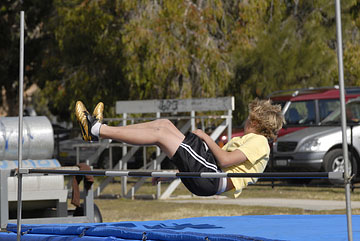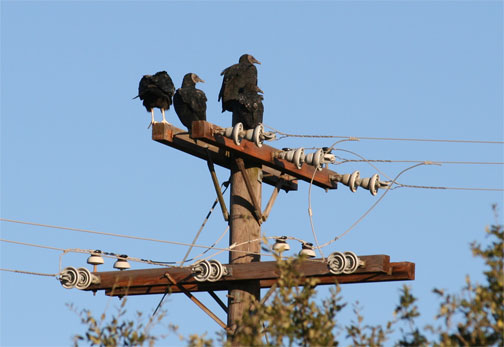When I was in high school, I was a member of the track team. I wasn’t the fastest sprinter or the best at long distances, but I served as a decent utility player, filling various roles as needed. During my three years on the track team, I was a high jumper, a hurdler, a member of the sprint relay team, and a shot putter. Believe it or not, shot put was my best event. What I lacked in size and strength I made up in technique and quickness. I took great pleasure in beating guys who outweighed me by a hundred pounds.
I got into track because my friend Mike discovered high jumping when we were in ninth grade. For those of you who are not track and field afficionados, high jumping not pole valuting. Rather, it involves running up to a bar and jumping over it, landing safely in a foam pit. At least that’s the idea. Often high jumping means hitting the bar rather than clearing it, sometimes landing on it, which really hurts. And, every now and then, high jumpers miss the pit altogether, landing with a painful thump on the hard ground.
When Mike happened to try high jumping one day at the local community college, he liked it enough to get me hooked too. We’d spend hours running up to the bar and trying to jump over it. Back then, the Fosbury Flop, as it was called, had revolutionized high jumping. For decades most high jumpers rolled over the bar face down. But Dick Fosbury, an American high jumper, won the gold medal in the 1968 Olympics by going over the backwards, face to the sky. That seemed much more exciting to a couple of teenagers. Plus, the Flop was easier to learn than the Straddle Roll. So Mike and I were floppers.
 At first our goal was to clear five feet. After weeks of practice, we both made it over that height. Five feet wasn’t nearly enough to score in a high school boys track meet, but it was enough to give us confidence to try out for the Glendale High School track team. Both Mike and I made it as sophomore high jumpers. (Photo: A young high jumper using the flop method to clear what seems to be about four feet. I had that much hair or more when I was in high school!)
At first our goal was to clear five feet. After weeks of practice, we both made it over that height. Five feet wasn’t nearly enough to score in a high school boys track meet, but it was enough to give us confidence to try out for the Glendale High School track team. Both Mike and I made it as sophomore high jumpers. (Photo: A young high jumper using the flop method to clear what seems to be about four feet. I had that much hair or more when I was in high school!)
Glendale High School was high jump heaven back then. In 1972, when I began my sophomore year, the shadow of Dwight Stones loomed large over our high jump pit. He had been in the class of 1971, setting what was then the national high school record by jumping 7-1 1/2. In the summer of 1972, Dwight had won the bronze medal in the Munich Olympic games, on his way to setting the world record in 1973. Dwight had been coached to greatness by John Barnes, who was still the track coach at Glendale High. So, not only did I have Mr. Barnes to help me leap to greatness, but Dwight often hung out with us, giving pointers that were like gold.
During the spring of 1973, my high jump personal best kept rising, from 5-0 to 5-2 to 5-4 to 5-6 to 5-8. As near as I can remember, that’s the best I did while I sophomore. It was enough to score points in dual meets, but not especially noteworthy. Meanwhile, I found more success as a shot putter.
During my junior year, a couple of my classmates began to excel in high jump, so I stopped practicing in order to focus on other events. As the third man on the high jump squad, I rarely scored points in that event, while my colleagues often won. Thus endeth my high jump career, or so I thought.
But after the first invitational meet of my senior year, the two best high jumpers on my team got drunk on the bus coming home from the meet. Mr. Barnes promptly kicked them off the team. That meant I was drafted back into high jumping. I set my sights on clearing six feet, which was way more than I had ever done before. It was about my height and looked plenty high to me. In order to clear six feet, I had to get my body quite a bit higher in the air, simply by running and jumping up. That seemed darn near impossible to me, even though, by then, Dwight Stones had set the world record at 7-6 1/2.
For weeks I worked as hard as I could at high jump, focusing all my effort on clearing six feet. I worked up from 5-9 to 5-10, from 5-10 to 5-11. My attempts at six feet fizzled. Something about seeing the bar above my eyes freaked me out.
Then the long awaited day arrived. At a dual meet, I think somewhere in Burbank, California, I cleared the magic height. I had made six feet!
Mr. Barnes encouraged me to set my sights on something even greater. He envisioned me clearing 6-2, maybe even 6-4. Perhaps I could medal in the league championships. But something happened in me once I cleared six feet. I had fulfilled my great expectations. Or, you might say, I had fulfilled my less-than-great expectations. Something in me believed that I could go no higher. And so, as you can imagine, I went no higher. No amount of training or encouragement could get me over anything beyond six feet. My mind set the limit I would never exceed.
As I think back on my lackluster high jumping career, I have often considered how my expectations both urged me on and then limited me. Somehow, I knew deep inside that I could get to six feet. And, somehow, I also knew deep inside that I simply couldn’t go any higher. I wonder what would have happened if I had allowed myself to dream big. Of course I’ll never know, because now I think it’s a feat worthy of a medal if I can jump up into my bed.
I wonder where in my life today I’m limiting myself by my less-than-great expectations. What are my “six-foot-barriers” now?
More from Beliefnet and our partners

